 Toyota Yaris: Child restraint
Toyota Yaris: Child restraint
—Child restraint precautions
Toyota strongly urges the use of appropriate child restraint systems for children.
The laws of all 50 states in the U.S.A.
and Canada now require the use of a child restraint system.
Your vehicle conforms to SAE J1819.
If a child is too large for a child restraint system, the child should sit in the rear seat and must be restrained using the vehicle’s seat belt. See “Seat belts” in this Section for details.
CAUTION.
For effective protection in automobile accidents and sudden stops, a child must be properly restrained, using a seat belt or child restraint system depending on the age and size of the child. Holding a child in your arms is not a substitute for a child restraint system. In an accident, the child can be crushed against the windshield, or between you and the vehicle’s interior.
Toyota strongly urges use of a proper child restraint system which conforms to the size of the child, installed on the rear seat. According to accident statistics, the child is safer when properly restrained in the rear seat than in the front seat.
Never install a rear-facing child restraint system on the front passenger seat even if the “AIRBAG OFF” indicator light is illuminated. In the event of an accident, the force of the rapid inflation of the front passenger airbag can cause death or serious injury to the child if the rear-facing child restraint system is installed on the front passenger seat.
A forward-facing child restraint system should be allowed to be installed on the front passenger seat only when it is unavoidable.
Always move the seat as far back as possible even if the “AIRBAG OFF” indicator light is illuminated, because the front passenger airbag could inflate with considerable speed and force. Otherwise, the child may be killed or seriously injured.
On vehicles with side airbags and curtain shield airbags, do not allow the child to lean his/her head or any part of his/her body against the door or the area of the seat, front or rear pillar or roof side rail from which the side airbags or curtain shield airbags deploy even if the child is seated in the child restraint system. It is dangerous if the side airbag and curtain shield airbag inflate, and the impact could cause death or serious injury to the child.
Do not use the seat belt extender when installing a child restraint system on the front or rear passenger seat. If installing a child restraint system with the seat belt extender connected to the seat belt, the seat belt will not securely hold the child restraint system, which could cause death or serious injury to the child or other passengers in the event of collision.
Make sure you have complied with all installation instructions provided by the child restraint manufacturer and that the system is properly secured.
If it is not secured properly, it may cause death or serious injury to the child in the event of a sudden stop or accident.
—Child restraint system
A child restraint system for a small child or baby must itself be properly restrained on the seat with the lap portion of the lap/shoulder belt. You must carefully consult the manufacturer’s instructions which accompany the child restraint system.
To provide proper restraint, use a child restraint system following the manufacturer’s instructions about the appropriate age and size of the child for the child restraint system.
Install the child restraint system correctly following the instructions provided by its manufacturer. General directions are also provided under the following illustrations.
The child restraint system should be installed on the rear seat. According to accident statistics, the child is safer when properly restrained in the rear seat than in the front seat.
When not using the child restraint system, keep it secured with the seat belt or place it somewhere other than the passenger compartment. This will prevent it from injuring passengers in the event of a sudden stop or accident.
—Types of child restraint system
Child restraint systems are classified into the following 3 types depending on the child’s age and size.
(A) Infant seat.
(B) Convertible seat.
(C) Booster seat.
Install the child restraint system following the instructions provided by its manufacturer.
Your vehicle has anchor brackets for securing the top strap of a child restraint system.
For instructions about how to use the anchor bracket, see “—Using a top strap” in this Section.
The child restraint lower anchorages approved for your vehicle may also be used. See “—Installation with child restraint lower anchorages” in this Section.
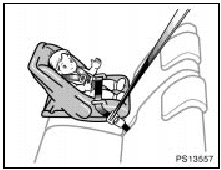
(A) Infant seat
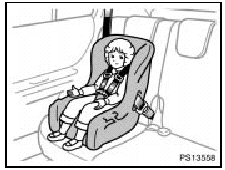
(B) Convertible seat
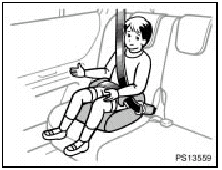
(C) Booster seat
—Installation with seat belt
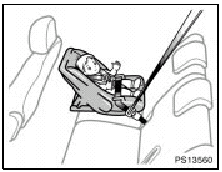
(A) INFANT SEAT INSTALLATION
An infant seat must be used in rear- facing position only.
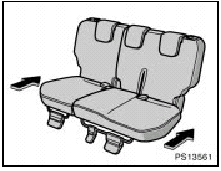
CAUTION.
Split seat: When installing a rear- facing child restraint system in the rear seat, move the rear seat to the rear-most lock position to prevent the child restraint system from interfering with the front seat. Otherwise, the child restraint system may not be properly secured. In the event of an accident, this may cause death or serious injury.
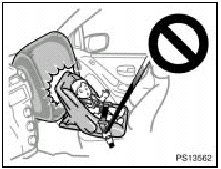
CAUTION.
Never install a rear-facing child restraint system on the front passenger seat even if the “AIRBAG OFF” indicator light is illuminated. In the event of an accident, the force of the rapid inflation of the front passenger airbag can cause death or serious injury to the child if the rear-facing child restraint system is installed on the front passenger seat.
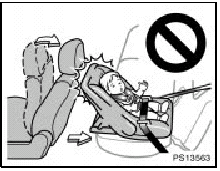
Do not install a child restraint system on the rear seat if it interferes with the lock mechanism of the front seats. Otherwise, the child or front seat occupant(s) may be killed or seriously injured in case of sudden braking or a collision.
If the driver’s seat position does not allow sufficient space for safe installation, install the child restraint system on the rear right seat.
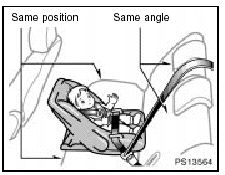
Split seat: When installing a child restraint system in the rear seat center position, adjust both seat cushions to the same position and align both seatbacks at the same angle. Otherwise, the child restraint system cannot be securely restrained and this may cause death or serious injuries in a collision.
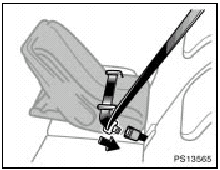
1. Run the lap and shoulder belt through or around the infant seat following the instructions provided by its manufacturer and insert the tab into the buckle taking care not to twist the belt. Keep the lap portion of the belt tight.
CAUTION.
After inserting the tab, make sure the tab and buckle are locked and that the lap and shoulder portions of the belt are not twisted.
Do not insert coins, clips, etc. in the buckle as this may prevent your child from properly latching the tab and buckle.
If the seat belt does not function normally, it cannot protect your child from death or serious injury.
Contact your Toyota dealer immediately.
Do not install the child restraint system on the seat until the seat belt is fixed.
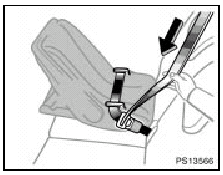
2. Fully extend the shoulder belt to put it in the lock mode. When the belt is then retracted even slightly, it cannot be extended.
To hold the infant seat securely, make sure the belt is in the lock mode before letting the belt retract.
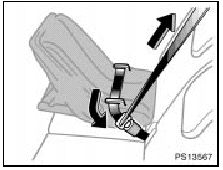
3. While pressing the infant seat firmly against the seat cushion and seatback, let the shoulder belt retract as far as it will go to hold the infant seat securely.
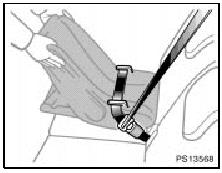
CAUTION.
Push and pull the child restraint system in different directions to be sure it is secure. Follow all the installation instructions provided by its manufacturer.
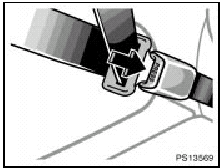
4. To remove the infant seat, press the buckle release button and allow the belt to retract completely. The belt will move freely again and be ready to work for an adult or older child passenger.
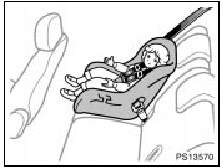
(B) CONVERTIBLE SEAT INSTALLATION
A convertible seat must be used in forward- facing or rear-facing position depending on the age and size of the child. When installing, follow the manufacturer’s instructions about the applicable age and size of the child as well as directions for installing the child restraint system.
Install the child restraint system on the front passenger seat only when it is unavoidable.
Your vehicle is equipped with a front passenger occupant classification system.
In order to activate the occupant classification system correctly, install the forward-facing
child restraint system on the front passenger seat in the following order:
1. Turn the ignition key to the “ON” position.
2. Move the front passenger seat to the rearward position.
3. If you must install the child restraint system on the front passenger seat, put the child restraint system putting your weight on the front passenger seat.
4. Insert the seat belt tab into the seat belt buckle.
5. Fully extend the shoulder belt to put it in the lock mode. When the belt is then retracted even slightly, it cannot be extended. To hold the seat securely, make sure the belt is in the lock mode before letting the belt retract.
6. While pressing the convertible seat firmly against the seat cushion and seatback, let the shoulder belt retract as far as it will go to hold the convertible seat securely.
CAUTION.
Push and pull the child restraint system in different directions to be sure it is secure. Follow all the installation instructions provided by its manufacturer.
7. Put a child on the child restraint system and secure the child, complying with the instructions provided by the child restraint system manufacturer.
The “AIRBAG OFF” indicator light should be illuminated when the ignition key
is in the “ON” position and the child is in the child restraint system after following
these procedures. The “AIRBAG OFF” indicator light indicates the SRS front passenger
airbag and side airbag on the passenger side will not deploy. If the “AIRBAG ON”
indicator light is illuminated, do the following procedure:
1. Turn the ignition off.
2. Remove the child restraint system.
3. When reinstalling a child restraint system, make sure the seatback does not press the child restraint system into the seat cushion. If this occurs, adjust the seatback angle slightly.
4. Then make sure the head restraint is not pressing the child restraint system into the seat cushion. If this occurs, raise the head restraint.
5. Turn the ignition on again.
The “AIRBAG OFF” indicator light should be illuminated. If the “AIRBAG ON” indicator light is illuminated when the ignition key is turned to the “ON” position, then the SRS front passenger airbag and side airbag on the passenger side may deploy in an accident. Do not drive the vehicle in this condition. Remove the child restraint system and contact your Toyota dealer.
CAUTION.
Never install a rear-facing child restraint system on the front passenger seat. A forward-facing child restraint system should only be installed on the front passenger seat when unavoidable. If you must install the child restraint system on the front passenger seat, put the seat in its most rearward position, and install the forward-facing child restraint system in the proper order. Otherwise, the front passenger occupant classification system cannot detect the presence of the child restraint system and the front passenger airbag and side airbag on the front passenger seat could deploy.
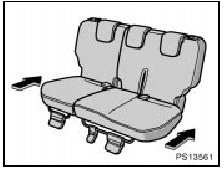
CAUTION.
Split seat: When installing a rear- facing child restraint system in the rear seat, move the rear seat to the rear-most lock position to prevent the child restraint system from interfering with the front seat. Otherwise, the child restraint system may not be properly secured. In the event of an accident, this may cause death or serious injury.
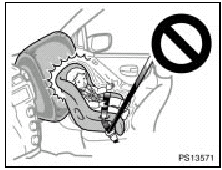
CAUTION.
Never install a rear-facing child restraint system on the front passenger seat even if the “AIRBAG OFF” indicator light is illuminated. In the event of an accident, the force of the rapid inflation of the front passenger airbag can cause death or serious injury to the child if the rear-facing child restraint system is installed on the front passenger seat.
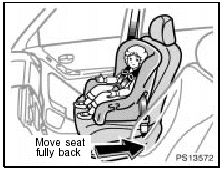
CAUTION.
Never install a rear-facing child restraint system on the front passenger seat even if the “AIRBAG OFF” indicator light is illuminated. In the event of an accident, the force of the rapid inflation of the front passenger airbag can cause death or serious injury to the child if the rear-facing child restraint system is installed on the front passenger seat.
On vehicles with side airbags and curtain shield airbags, do not allow the child to lean his/her head or any part of his/her body against the door or the area of the seat, front or rear pillar or roof side rail from which the side airbags or curtain shield airbags deploy even if the child is seated in the child restraint system. If is dangerous if the side airbag and curtain shield airbag inflate, and the impact could cause death or serious injury to the child.
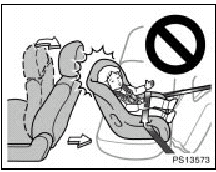
Do not install a child restraint system on the rear seat if it interferes with the lock mechanism of the front seats. Otherwise, the child or front seat occupant(s) may be killed or seriously injured in case of sudden braking or a collision.
If the driver’s seat position does not allow sufficient space for safe installation, install the child restraint system on the rear right seat.
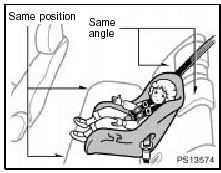
Split seat: When installing a child restraint system in the rear seat center position, adjust both seat cushions to the same position and align both seatbacks at the same angle. Otherwise, the child restraint system cannot be securely restrained and this may cause death or serious injuries in a collision.
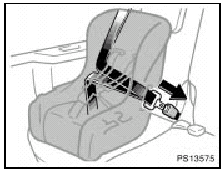
1. Run the lap and shoulder belt through or around the convertible seat following the instructions provided by its manufacturer and insert the tab into the buckle taking care not to twist the belt. Keep the lap portion of the belt tight.
CAUTION.
After inserting the tab, make sure the tab and buckle are locked and that the lap and shoulder portions of the belt are not twisted.
Do not insert coins, clips, etc. in the buckle as this may prevent your child from properly latching the tab and buckle.
If the seat belt does not function normally, it cannot protect your child from death or serious injury.
Contact your Toyota dealer immediately.
Do not install the child restraint system on the seat until the seat belt is fixed.
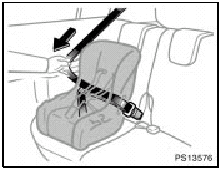
2. Fully extend the shoulder belt to put it in the lock mode. When the belt is then retracted even slightly, it cannot be extended.
To hold the convertible seat securely, make sure the belt is in the lock mode before letting the belt retract.
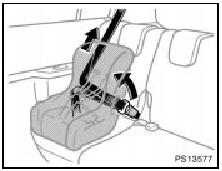
3. While pressing the convertible seat firmly against the seat cushion and seatback, let the shoulder belt retract as far as it will go to hold the convertible seat securely.
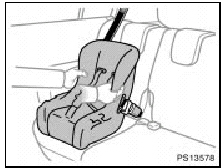
CAUTION.
Push and pull the child restraint system in different directions to be sure it is secure. Follow all the installation instructions provided by its manufacturer.
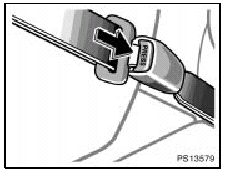
4. To remove the convertible seat, press the buckle release button and allow the belt to retract completely. The belt will move freely again and be ready to work for an adult or older child passenger.
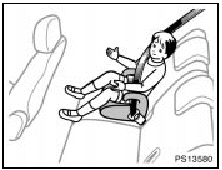
(C) BOOSTER SEAT INSTALLATION
A booster seat must be used in forward- facing position only.
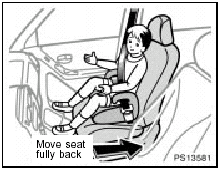
CAUTION.
A forward-facing child restraint system should be allowed to be installed on the front passenger seat only when it is unavoidable.
Always move the seat as far back as possible even if the “AIRBAG OFF” indicator light is illuminated, because the front passenger airbag could inflate with considerable speed and force. Otherwise, the child may be killed or seriously injured.
On vehicles with side airbags and curtain shield airbags, do not allow the child to lean his/her head or any part of his/her body against the door or the area of the seat, front or rear pillar or roof side rail from which the side airbags or curtain shield airbags deploy even if the child is seated in the child restraint system. It is dangerous if the side airbag and curtain shield airbag inflate, and the impact could cause death or serious injury to the child.
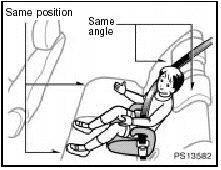
When installing a child restraint system in the rear seat center position, adjust both seat cushions to the same position and align both seatbacks at the same angle. Otherwise, the child restraint system cannot be securely restrained and this may cause death or serious injuries in a collision.
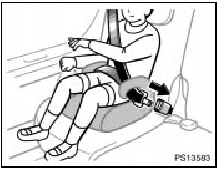
1. Sit the child on a booster seat. Run the lap and shoulder belt through or around the booster seat and across the child following the instructions provided by its manufacturer and insert the tab into the buckle taking care not to twist the belt.
Make sure the shoulder belt is correctly across the child’s shoulder and that the lap belt is positioned as low as possible on the child’s hips. See “Seat belts” in this Section for details.
CAUTION.
Always make sure the shoulder belt is positioned across the center of child’s shoulder. The belt should be kept away from child’s neck, but not falling off child’s shoulder.
Otherwise, the child may be killed or seriously injured in case of sudden braking or a collision.
Both high-positioned lap belts and loose-fitting belts could cause death or serious injuries due to sliding under the lap belt during a collision or other unintended event.
Keep the lap belt positioned as low on a child’s hips as possible.
For child’s safety, do not place the shoulder belt under child’s arm.
After inserting the tab, make sure the tab and buckle are locked and that the lap and shoulder portions of the belt are not twisted.
Do not insert coins, clips, etc. in the buckle as this may prevent your child from properly latching the tab and buckle.
If the seat belt does not function normally, it cannot protect your child from death or serious injury.
Contact your Toyota dealer immediately.
Do not install the child restraint system on the seat until the seat belt is fixed.
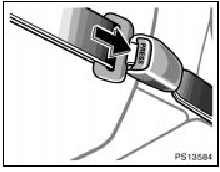
2. To remove the booster seat, press the buckle release button and allow the belt to retract.
—Using a top strap
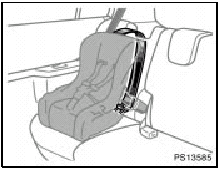
Follow the procedure below for a child restraint system that requires the use of a top strap.
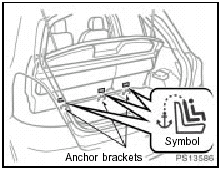
Use the anchor brackets behind the rear seatbacks to attach the top strap.
Anchor brackets are installed for each rear seating position.
This symbol indicates the locations of user ready anchor brackets.
TO USE THE ANCHOR BRACKET:
1. Remove the deck board and luggage storage box. (See “Luggage storage box”).
2. Remove the luggage cover. (See “Luggage cover”).
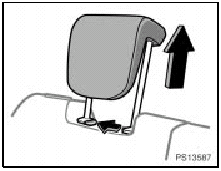
Split seat
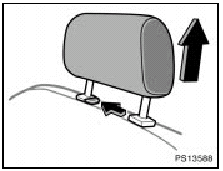
Non-split seat
3. Remove the head restraint.
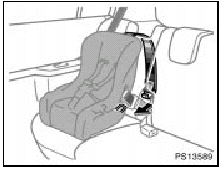
4. Securely fasten the child restraint system with the seat belt.
Latch the hook onto the anchor bracket and tighten the top strap.
For instructions to install the child restraint system, see “Child restraint” in this Section.
CAUTION.
Make sure the top strap is securely latched, and check that the child restraint system is secure by pushing and pulling it in different directions.
Follow all the installation instructions provided by its manufacturer.
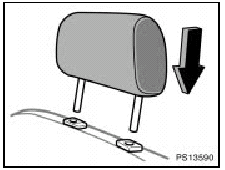
5. Non-split seat only—Replace the head restraint.
—Installation with child restraint lower anchorages
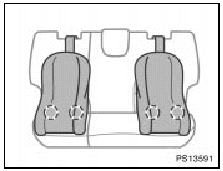
The lower anchorages for the child restraint system interfaced with the FMVSS225 or CMVSS210.2 specification are installed in the rear seat.
The anchorages are installed in the gap between the seat cushion and seatback of both outside rear seats.
Child restraint system interfaced with the FMVSS213 or CMVSS213 specification can be fixed with these anchorages. In this case, it is not necessary to fix the child restraint system with a seat belt on the vehicle.
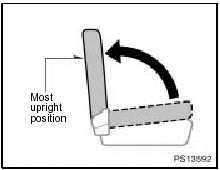
CHILD RESTRAINT SYSTEM INSTALLATION
1. Fold down the seatback and back it to the most upright position until it locks into place.
Make sure the seatback is locked securely.
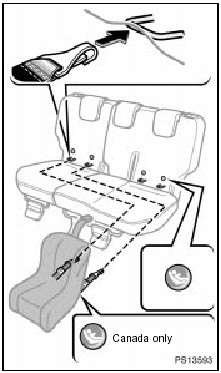
Type A
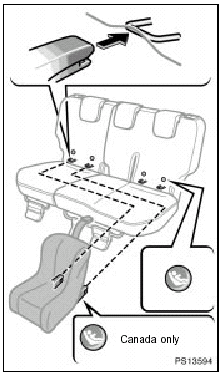
Type B
1. Widen the gap between the seat cushion and seatback slightly and confirm the position of the lower anchorages below the button on the seatback.
2. Type A—Latch the hooks of lower straps onto the anchorages and tighten the lower straps.
Type B—Latch the buckles onto the anchorages.
For owners in Canada
The symbol on a child restraint system indicates the presence of a lower connector system.
If your child restraint system has a top strap, it should be anchored. (For the installation of the top strap, see “—Using a top strap” in this Section.) For installation details, refer to the instruction manual equipped with each product.
CAUTION.
When using the lower anchorages for the child restraint system, be sure that there are no irregular objects around the anchorages or that the seat belt is not caught.
Push and pull the child restraint system in different directions to be sure it is secure. Follow all the installation instructions provided by its manufacturer.
Split seat—When using the lower anchorages for the child restraint system, ensure that the seat is moved to the rear-most position, with the seatback close to the child restraint system.
After securing the child restraint system, never slide or recline the seat.
Do not install a child restraint system on the rear seat if it interferes with the lock mechanism of the front seats. Otherwise, the child or front seat occupant(s) may be killed or seriously injured in case of sudden braking or a collision.
 Front passenger occupant classification system
Front passenger occupant classification system
Your vehicle is equipped with a front passenger occupant classification system.
This system detects the conditions.
Based on these conditions, the systems below are activated or deactivated: Front
...
See also:
Luggage cover
When you open the back door, the luggage cover tilts up for easy access to
the luggage area.
For additional luggage space, unhook the cords, remove the luggage cover from
the seatback and l ...
Maintenance and care
Cleaning and protecting your vehicle, performing do-ityourself maintenance, and
maintenance information. ...
Power outlet
The power outlet is designed for power supply for car accessories. To use
the power outlet, open as shown in the illustration.
The key must be in the “ACC” or “ON” position for the powe ...

